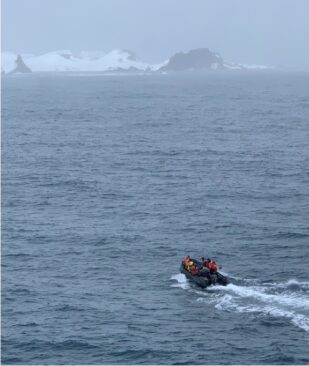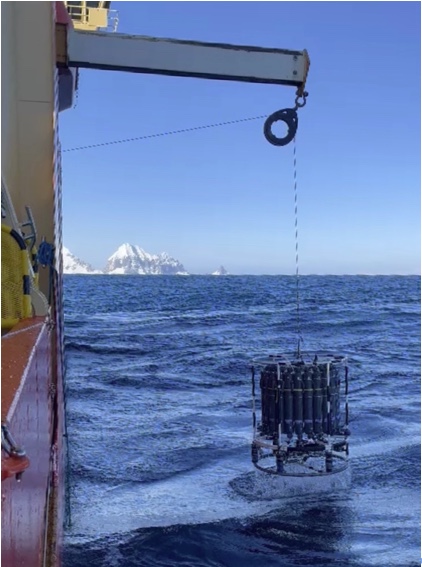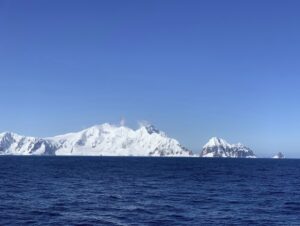-
Phytoplankton, Lords of The Sea!
Posted on December 8th, 2021 No commentsWednesday, December 1st
CURRENT PROGRESS: Happy Antarctica Day!
Hey everyone, Quintin here! I’m a biological oceanographer with the LTER (Long-Term Ecological Research) project here on the Nathaniel B. Palmer (NBP). It’s another day of exciting Antarctic scenery here looking through the portholes on the NBP, since a large storm is hitting the Western Antarctic Peninsula! While that gives us a lot of high winds and cool waves to look at, it also means we have to shut down science until the weather is safe enough to drop our instruments over the side. This is definitely unfortunate, but it gives us all a great chance to make plans for the rest of the expedition and process data!
So far we have made significant progress down the peninsula and have reached Adelaide Island, one of the major islands on the coast (and home to Rothera Station, an Antarctic research base owned by the British!). Now that we have come so far south and have completed nearly 60% of our expedition, we are making plans to do process studies at a couple locations along the coast. Unlike our previous sampling sights, we will stay at these process study locations for 2-3 days and sample every 12 hours or more! We do this so we can understand the differences in our respective focus areas (e.g., phytoplankton, bacteria, zooplankton, physics, etc.) over time and run experiments that require us to be in one location for an extended period. It should be an exciting time, and marks one of the final stretches of science before we start packing up and heading back to the US!
PHYTOPLANKTON: The Grass Of The Sea
For biological oceanographers, part of being out in the field on research trips like this one is to collect samples of the plants and animals that live in the ocean so we can gather data from them later. I and others in my lab are focused on collecting and studying the phytoplankton (microscopic plants) in the ocean, and that means lots of filtering water! Much like the grasses that cows graze on in farms or the grass in your front lawn, phytoplankton are essentially the grass of the sea. They are super tiny bits of plant, made up of a single cell, that are everywhere in the surface ocean. The only difference between the grass on your lawn and the algae (phytoplankton) in the ocean is that the algae are too small to see! Despite being so small, the phytoplankton are super important to the ecosystem, since they are the ones that harvest energy from the sun and make it available to all the larger critters like zooplankton that are eaten by whales, seals, and penguins. Because the phytoplankton are so important, we want to understand how much there is, how they grow over time, and what different kinds of phytoplankton exist in the water. This information can tell us a lot about the base of the food web and how we might expect it to change over time to impact all of the larger critters that thrive in the unique Antarctic areas!

A picture of a diatom taken by a special camera called an Imaging Flow CytoBot. Diatoms are a type of phytoplankton that live all over the world, and there are many diatoms in the Southern Ocean near Antarctica.
About the author: Quintin Diou-Cass is a graduate student at Rutgers University. This is his fifth research cruise.
-
Let the science begin!!!
Posted on December 8th, 2021 No commentsWhat: Science on the research vessel Nathaniel B. Palmer has begun!
When: November 20 to November 22, 2021
Where: The ocean along the coast on the west side of the Antarctic Peninsula. The Antarctic Peninsula is the part of Antarctica that sticks up like a finger toward the southern tip of South America.
Why? We want to know what is going on with the ice, plants, and animals, and whether the conditions are changing from year to year.
Good morning from the research vessel Nathaniel B. Palmer in the waters west of the Antarctic Peninsula. I am happy to report that we have started doing science!
Our first order of business was to drop off a field camp on an island. A group of seven scientists will live there for a month. Their main job is to walk around the island every day counting and observing all the seabirds and seals. Their camp is a few small wooden buildings up on a snowy hill. To get there, they had to make many trips back and forth from the ship to the island in small inflatable motorboats called “zodiacs.” One trip would be for people, then the next trip would be for a load of gear… and repeat! To get on the boast, people had to descend from the high edge of the ship into the small boat down in the water many feet below. They climbed down a rope ladder and dropped into the small boat one by one. We are thinking of our friends at the field camp and we hope they are doing well. We will pick them up after the end of our research cruise on our way back to port in South America.

A small boat called a “zodiac” drives out to drop off seal and seabird researchers at Cape Shirreff on Livingston Island, one of the South Shetland Islands.
After dropping off the field camp, we started sampling the water! Now that we have started sampling, each day when we go down to the labs, we ask, “When is the next CTD?” What we mean is, “When is the next time we are sending our big frame of bottles down into the ocean to get water?” The term “CTD” stands for Conductivity, Temperature, and Depth. Conductivity is a measure of the ocean’s salinity. The CTD is a small machine at the bottom of our big white frame we send into the water. The big white frame is called a “rosette” because it is a circle of bottles, or the “CTD-rosette.” Each bottle is open at both ends when it goes down through the water. Then, on the way back up, we sit at a computer that connects to the CTD-rosette and tell it when to close the bottles at lots of different depths below the surface. When we want to close a bottle underwater, we click a button on the computer that says “Fire!”

The CTD-rosette going into the water at the first place where we did our science sampling.
After our first few stations, we are steaming south. We have passed 64 degrees south latitude, which means the days are getting long. The sun comes up at about 3:00 AM and sets at about 11:00 PM, but it never fully gets dark. Instead, it looks like sunset and sunrise are one long time of day, where the sky looks like it does at dusk and dawn in the United States.

A view of the snowy mountains surrounding Bransfield Strait, the first place where we did our science sampling.
About the author: Jessie Turner is a postdoc (researcher) at the University of Connecticut. This is her fourth big research cruise.



